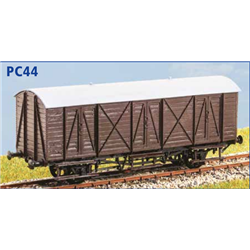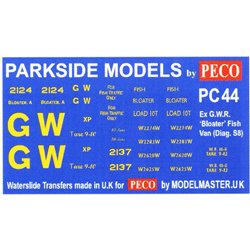A turntable is a device that enables locomotives and/or rolling stock to change direction or orientation. It consists...
No products
Product successfully added to your shopping cart
There are 0 items in your cart. There is 1 item in your cart.
Search Tips
Whare are GWR "bloater" vans?
The GWR bloater vans were a specialised fleet of railway vans built by the Great Western Railway (GWR) for transporting fish, particularly bloaters, from coastal regions to inland markets. First introduced in 1916, these vans were designed to replace an ageing fleet of older designs used for fish transport.
Bloater vans were reserved solely for fish traffic, reflecting the perishable nature of their cargo. They primarily operated from major fishing ports in Cornwall and Pembrokeshire, ensuring that fresh fish could be swiftly and efficiently transported to urban markets, including London.
Classed as Non-Passenger-Carrying Coaching Stock (NPCCS), these vans were equipped with through-piping for steam heating and were rated to run at express speeds with passenger trains. This capability allowed them to integrate seamlessly into passenger services, ensuring timely delivery of fresh fish.
Three common variants of the bloater vans were produced: Diagram S8, S9, and S10. These variants included both vacuum-braked vans and those fitted with both vacuum and Westinghouse air brakes. The latter were initially coded as 'Bloater A,' but by the early 1930s, their air brakes had been removed, and they were recoded to 'Bloater.'
Longer than standard goods vans, bloater vans featured three pairs of doors on each side, facilitating easy loading and unloading. The Diagram S8 vans, in particular, had louvres in the body sides and ends for ventilation, which was crucial for maintaining the quality of the fish during transit.
To aid loading in the dark, gas lighting was fitted, with gas light tops visible on the roof and the gas cylinder mounted below the solebar. This detail underscored the GWR's commitment to ensuring the efficient handling and transport of perishable goods.
The GWR bloater vans played a vital role in the fish transport industry, supporting the fishing communities of Cornwall and Pembrokeshire and ensuring that fresh fish could reach markets across the UK. Their specialised design and operation are a testament to the innovative solutions developed by the GWR to meet the unique challenges of transporting perishable goods.
Click here to receive the tips weekly in your mailbox. You can unsubscribe at any time.









